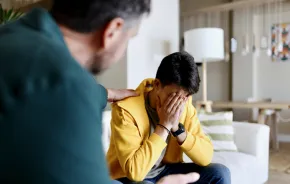
In recent years, more and more parents have become aware that there is a widely available vaccine that prevents life-threatening cancers, protects against genital warts and is available for free to many youths, including those in Washington state younger than age 19.
Yet despite this, only 40 percent of American girls and a mere 20 percent of American boys ages 13–17 get the vaccine for human papillomavirus (HPV), an easily acquired and potentially life-threatening infection. Compare that to the nearly 80 percent in vaccination rates for meningitis and around 90 percent for measles, mumps and rubella. What gives? One leading reason that so few children and teens receive the readily available protection against HPV, despite its wide availability, could come down to this: our fears and misconceptions about sex.
What is HPV?
Human papillomavirus is the nation’s most common sexually transmitted infection and a leading cause of cancers of the vagina, penis, anus and other “private” areas. But how much are our own hang-ups about sex denying our kids a healthier life?
Human papillomavirus is actually a group of viruses that can be transmitted through sexual contact, even when a condom is used, and can be spread whether or not there are symptoms (there often aren’t). About 79 million Americans currently have HPV, with 14 million newly infected every year. It’s so common, in fact, that the Centers for Disease Control and Prevention (CDC) says most sexually active people will get at least one type of HPV during their lives.
HPV also causes genital warts, which about 360,000 people get every year in the U.S. One in 100 sexually active American adults who have genital warts at any given time.
What does the vaccine do?
The Food and Drug Administration (FDA) currently licenses two HPV vaccines. One, Gardasil, prevents four HPV types, in addition to HPV 6 and 11, which cause 90 percent of genital warts; the other, Cervarix, prevents two HPV types that cause 70 percent of cervical cancers.
“Almost all cervical cancer cases have been found to be directly related to HPV,” says Sonja Olson, M.D., a family practice doctor at Seattle’s Country Doctor clinic. “If we prevented most HPV infections, we could eliminate almost all cervical cancers.”
We’re already seeing results. Even though vaccination rates are lower than doctors would like to see, the CDC reports a 56 percent reduction in the number of young women contracting HPV-related infections since the vaccine’s 2006 introduction. A 2016 study published in the journal Pediatrics showed that HPV rates have plummeted by 64 percent among women ages 14–19 and 34 percent among those ages 20–24.

So, what’s the problem?
“A lot of the resistance [to getting the vaccine] comes from the parents,” says Andrew Sinfuego, M.D., a pediatrician at Seattle’s Group Health Cooperative. “The main reason I hear is that their teens do not need it because they are not going to have sex or are not going to be [sexually active] until they get married.”
Olson sees the same thing. “I understand how there is the gut instinct for parents of preteens to hesitate about giving their child something that will prevent a sexually transmitted infection, because we all like to think of our kids as being kids forever and not doing adult things,” she says.
Of course, statistics tell a different story: 47 percent of teens in a 2013 CDC survey reported that they have had sexual intercourse. Of the teens who had had sex within the last three months, only 41 percent reported using a condom. Nearly half of the 20 million new cases of STDs each year are among young people ages 15–24.
A 2015 Harvard Medical School study found that physicians may actually discuss the vaccine in such a way that they discourage parents from investigating the option. “We were surprised that physicians so often reported recommending HPV vaccination inconsistently, behind schedule or without urgency,” says Melissa Gilkey, Ph.D., the study’s leader and an assistant professor of population medicine at Harvard. “We are currently missing many opportunities to protect young people from future HPV-related cancers.” Washington state ranks 12th for immunization of females (ages 13–17), at 43.8 percent; for boys in the same age range, we rank 13th, at 24.6 percent. Those numbers are still far behind those in other countries. In Australia, for example, the vaccine is offered in schools. There, in 2014, 73 percent of girls and 60 percent of boys turning 15 had completed the vaccine series.
Mandating the HPV vaccine in the U.S. has proven a controversial topic, although the vaccine itself is safe and proven effective (just two states, Rhode Island and Virginia and the District of Columbia, currently require HPV vaccines). Side effects are rare; those reported include mild pain at the injection side, nausea or fever. More severe reactions are extremely rare.
Ten years on the market and five years of clinical testing, however, have not dissipated misconceptions. Sinfuego recalls a mother who got mad after the father of her daughter had her get the first dose of the vaccine. “She said we ‘infected’ her with HPV,” says the doctor. “I was trying to explain that this is an inactivated virus vaccine, so it cannot infect the person receiving the vaccine, but she was adamant. She made us place a note on her daughter’s chart that she is not to receive any other doses of the vaccine.”
Your kids are going to do it
Let’s face it: At some point, sooner or a bit later, our kids are going to be sexually active. Most parents, when we set aside our fears or discomfort thinking of our children as sexual beings, would agree that we want their experiences to be as healthy and positive as possible. HPV is common. It causes cancer. And now, we can fight it.
HPV vaccination 101
- A series of three shots given over a six-month period
- Most effective if completed before sexual activity begins
- First dose given: now. Second dose: one–two months after first dose. Third dose: four months after second dose. All three doses are required.
- Females: ages 11–12; available to women 13–26
- Males: receive only Gardasil vaccine. Ages 13–21; may be given to males 22–26
- Recommended for all sexual orientations
Source: Washington State Department of Health











